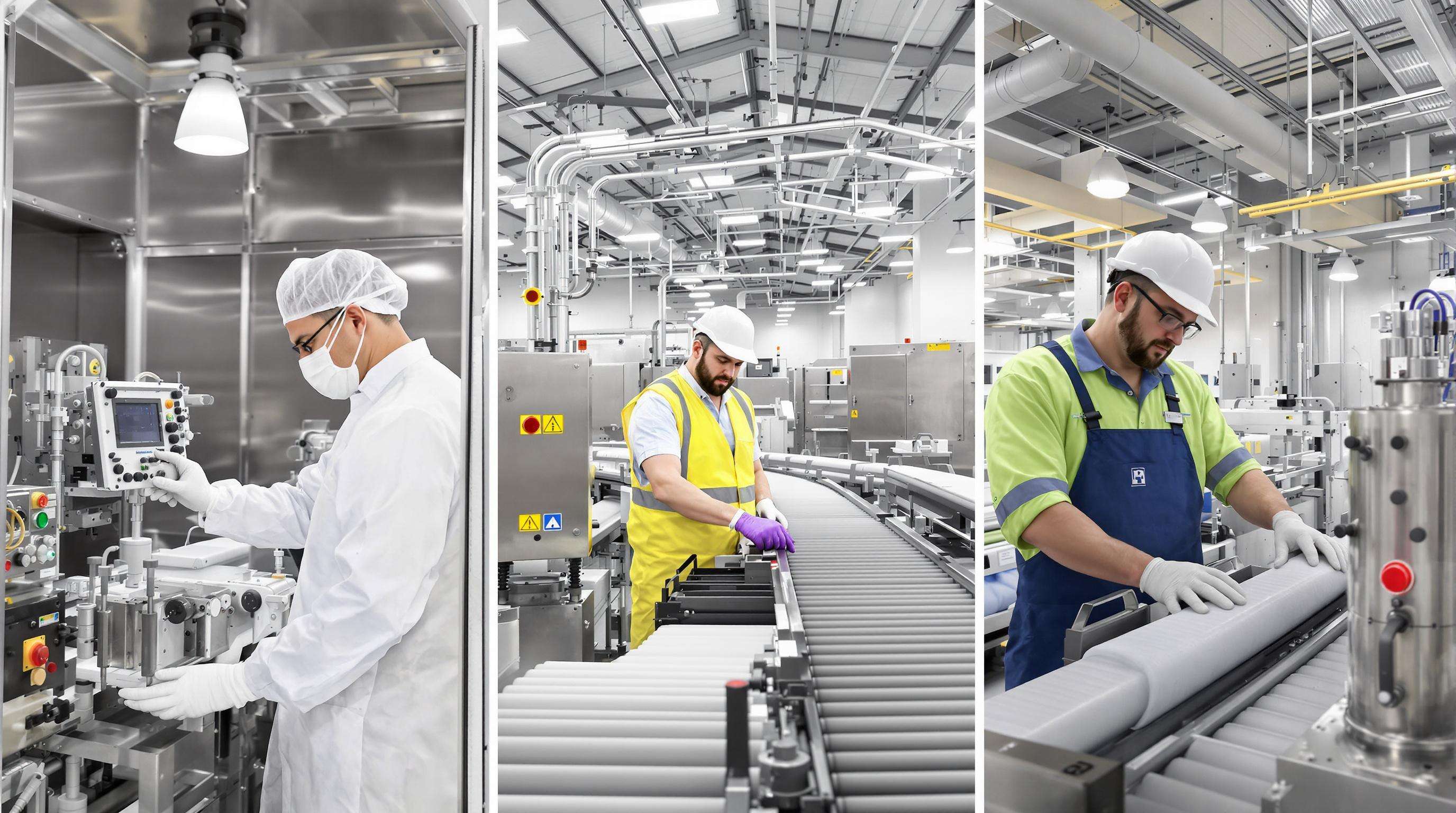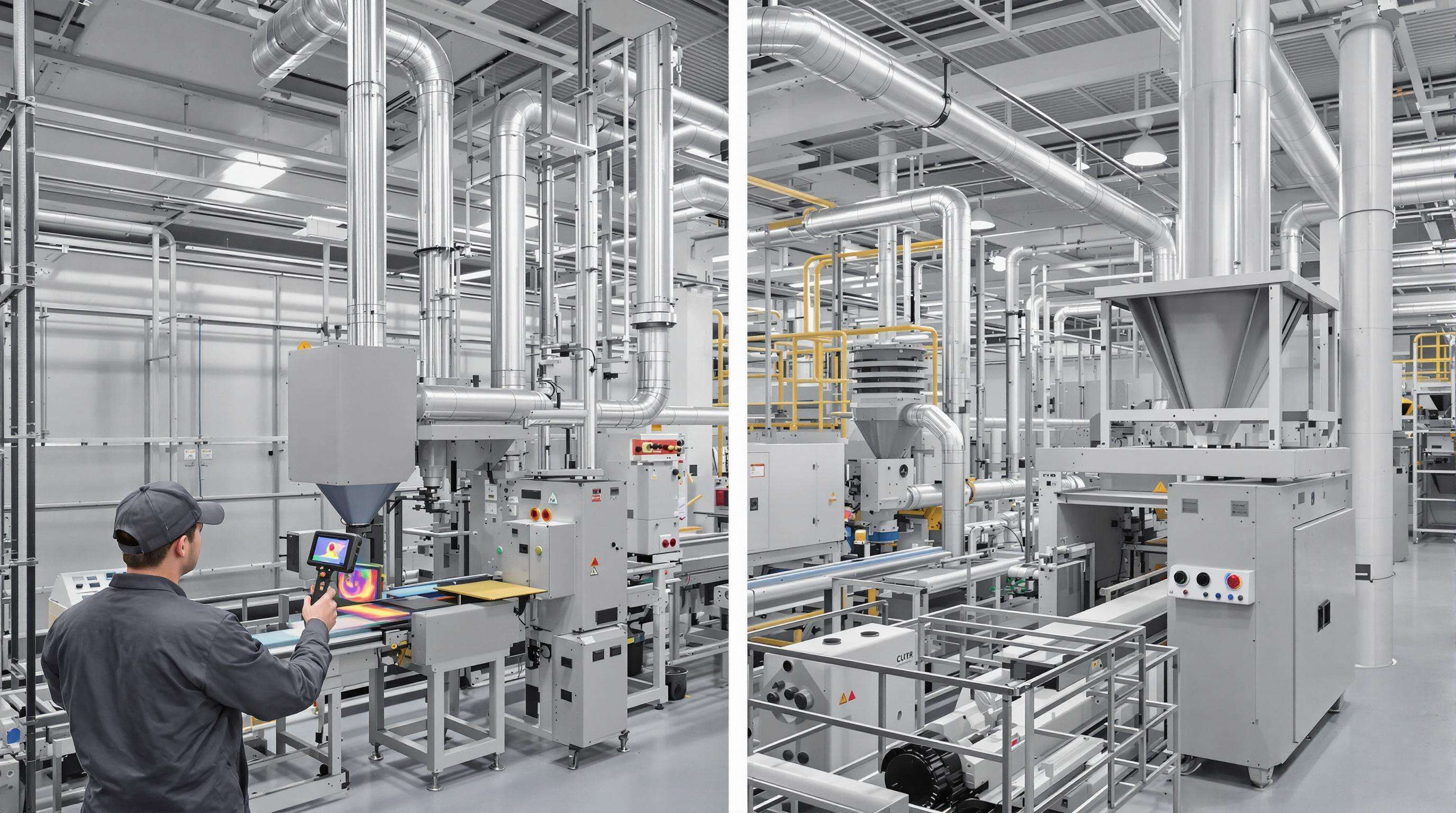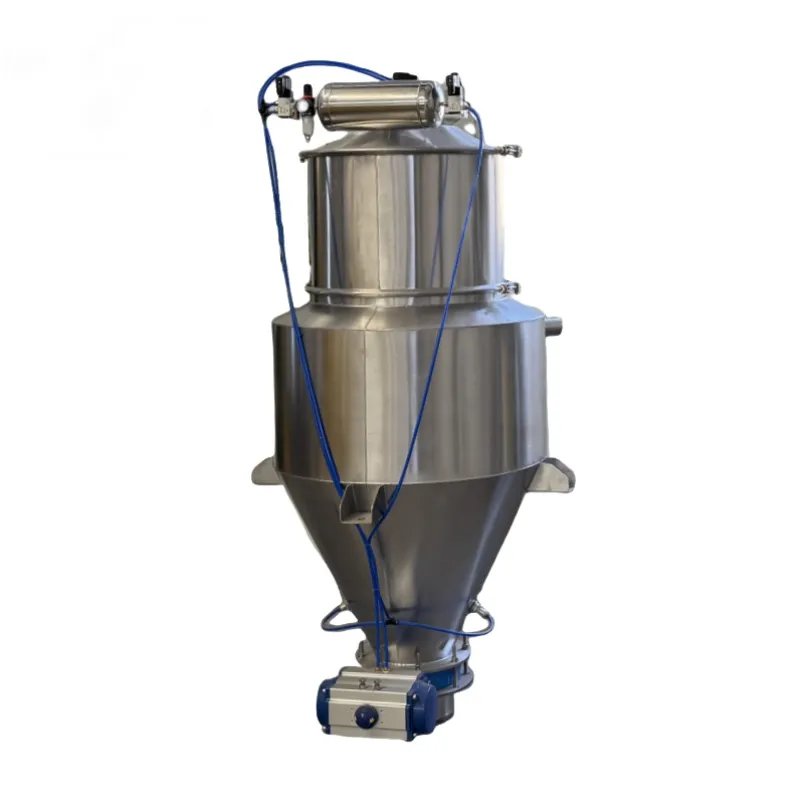Sistema ng pagdadala ng materyales Mga Pangunahing Kinakailangan Ayon sa Industriya

Ang mga sistema ng paghahatid ng materyales ay dapat na umaayon sa mga patakaran at pangangailangan ng operasyon na partikular sa industriya upang matiyak ang kaligtasan, kahusayan, at pagkakatugma.
Sa mga Pabrika ng Parmasyutiko , mga sistema ay binibigyan-priyoridad ang pag-iwas sa kontaminasyon sa pamamagitan ng mga disenyo ng saradong sistema at pagkakasunod sa kasalukuyang Mabuting Praktika sa Paggawa (cGMP). Ayon sa mga pag-aaral, ang mga system na sumusunod sa cGMP ay nagbawas ng 83% sa panganib ng cross-contamination sa produksyon ng mataas na potency na gamot ( PharmaTech Journal 2023).
Ang sektor ng pagproseso ng pagkain nangangailangan ng kagamitang sumusunod sa FDA at USDA na may mga materyales tulad ng AISI 304/316 stainless steel, na lumalaban sa paglago ng mikrobyo. Ang mga sanitary standard tulad ng 3-A at EHEDG ay nagsasaad ng mga nakakiling ibabaw, madaling alisin na sintas, at walang karugtong na mga sumpian upang maiwasan ang kontaminasyon ng alerheno.
Paggawa ng plastik nangangailangan ng mga mekanismo para kontrolin ang kuryenteng static upang maiwasan ang pagkabundok ng resin at panganib ng pagsabog, kasama ang mga bahagi na lumalaban sa pagsusuot para sa paghawak ng glass-filled polymers. Ang hindi napapamahalaang static na singil ay nagdudulot ng 23% na pagkawala ng materyales sa paghahatid ng polypropylene ( Plastics Engineering 2022).
Ang pagbabalanse ng mga kinakailangan ay madalas na naglilikha ng isang cost-purity paradox: ang mas mahigpit na kontrol sa kontaminasyon ay nagpapataas ng gastos ng capital ng 40–60%, samantalang ang cost-optimized na disenyo ay may panganib na hindi sumunod sa regulasyon.
Pharma Material Conveying System: cGMP Compliance
Ang mga sistema ng paghahatid ng parmasyutiko ay kumikilos alinsunod sa mahigpit na mga regulasyon ng kasalukuyang Good Manufacturing Practice (cGMP) upang matiyak ang kaligtasan at epektibidad ng produkto. Dapat tupdin ng mga sistemang ito ang mga pamantayan ng FDA 21 CFR Part 211, na namamahala sa kwalipikasyon ng kawani, pagpapatunay ng kagamitan, at integridad ng dokumentasyon.
Mga Protocolo sa Pagpapatunay para sa Makapangyarihang Mga Sangkap
Ang mga Makapangyarihang Aktibong Mga Ingrediente ng Parmasyutiko (APIs) ay nangangailangan ng mga protocolo ng Installation Qualification (IQ), Operational Qualification (OQ), at Performance Qualification (PQ) upang patunayan ang integridad ng sistema. Dapat magpakita ang pagpapatunay ng paglilinis ng mga antas ng residuo na nasa ilalim ng 10 ppm para sa mga nakakalason na sangkap ( Gabay ng FDA 2023).
Mga Pamantayan sa Kontrol ng Kontaminasyon (EU Annex 1)
Nagtatag ang EU Annex 1 ng kalidad ng hangin na ISO Class 5 para sa paghahatid ng sterile na produkto, na may ≤ 3,520 partikulo (≥ 0.5μm) bawat kubikong metro. Kailangang isama ng mga pneumatic system ang HEPA H14 filter at panatilihin ang positive pressure gradient na ≥15 Pa sa pagitan ng mga zone.
Paggawa ng Disenyo ng Saradong Sistema
Ang mga sistema ng pagsasara ng paghahatid ay binabawasan ang panganib ng kontaminasyon ng 98% kumpara sa mga bukas na konpigurasyon ( PDA Technical Report 83 ). Mga disenyo na sumusunod sa cGMP:
- Tri-clamp sanitary fittings na may mga surface na gawa sa 316L stainless steel
- Nitrogen inertization para sa mga compound na sensitibo sa oxygen
- CIP (Clean-in-Place) spray balls na may 2.0 m/s flush velocity
Mga Solusyon sa Pagsubaybay ng Datos
ang cGMP §211.188 ay nagsasagawa ng kumpletong pagsubaybay mula sa pagtanggap ng hilaw na materyales hanggang sa pangwakas na pag-packaging. Ang mga modernong sistema ay gumagamit ng:
- Mga lalagyan ng materyales na may RFID tag na may real-time na pagsubaybay ng lokasyon
- Mga load cell na naka-integrate sa SCADA (±0.25% na katiyakan) para sa pag-verify ng mass balance
- Mga talaan ng batch na nakaseguro sa pamamagitan ng blockchain upang maiwasan ang pagbabago ng datos
Disenyo ng Sistema ng Pagdadala ng Materyales na Angkop sa Pagkain
Mga Pamantayan sa Kalinisan: 3-A kumpara sa EHEDG
Ang mga sistema ng paghahatid na food-grade ay dapat sumunod sa alinman sa 3-A Sanitary Standards (karaniwan sa North American dairy operations) o sa gabay ng EHEDG (mga alituntunin sa kalinisan sa Europa para sa mga handa nang kainin na pagkain). Habang ang 3-A ay nangangailangan ng mga welded frame at AISI 300-series stainless steel, ang EHEDG ay binibigyang-pansin ang kalinisan sa pamamagitan ng mga limitasyon sa kabuuhan ng ibabaw (Ra ≤ 0.8 µm) at mga gilid na may radius.
Paggalaw sa Pagpapakalat ng Allergen
Ang mga modernong sistema ay nakakapigil sa paggalaw ng allergen sa pamamagitan ng mga nakalaang linya ng pagdadala, mga modular na bahagi na may iba't ibang kulay, at awtomatikong CIP cycle kasama ang pagkakasunod-sunod ng detergent na partikular sa allergen. Ayon sa isang pagsusuri ng FDA noong 2023, ang 74% ng mga insidente na may kinalaman sa allergen ay nagmula sa mga pinagsasamang conveyor system.
Inhinyerya ng Kompatibilidad sa Paglilinis
IP69K-rated stainless steel motors at food-grade PTFE chain guides ay nakakatagal ng pang-araw-araw na paglilinis gamit ang mataas na presyon (1,450 PSI na tubig sa 185°F). Ang mga anggulo ng pagbagsak na ≥3° ay nakakapigil sa pagtigip ng likido, habang ang mga laser-welded seams ay nagtatanggal ng mga puwang na nakakapigil ng kahalumigmigan.
Mga Hamon sa Kahusayan ng Material Conveying sa Plastik

Ang mga systema ng material conveying sa proseso ng plastik ay dapat balansehin ang demanda sa throughput kasabay ng tumpak na kontrol sa mga katangian ng materyales. Ang mga inefisiensiya ng sistema ay nagsisimula sa 18% ng mga gastos sa produksyon sa mga pasilidad ng injection molding ( Teknolohiya ng Plastik 2023).
Mga Panganib ng Pagkasira dahil sa Init ng Pagkakagiling
Ang mabilis na paghahatid ay nagbubuo ng lokal na temperatura na lumalampas sa 160°C sa mga systema ng PET, nagpapabilis ng pagkasira ng polymer ng 0.8% bawat minuto ng pagkakalantad. Ang mga transfer screws na may ceramic coating kasama ang infrared thermal monitoring ay nagbabawas ng pagkawala ng molecular weight ng 63%.
Control sa Elektrisidad sa Paglipat ng Resin
Ang mga electrostatic charge na nasa itaas ng 5 kV sa mga pneumatic line ay nagdudulot ng filler separation at panganib ng pagsabog sa produksyon ng ABS. Ang mga conductive polypropylene liner (surface resistivity <10^6 Ω) na pinagsama sa mga kapaligiran na kontrolado ang kahaluman (50-60% RH) ay nakakamit ng 97% na charge dissipation.
Mga Teknik sa Paglaban sa Pagkasira
Ang glass-filled nylon compounds ay nagdudulot ng 3mm na pagsusuot kada taon sa hindi protektadong steel conveyors. Ang ultra-high-molecular-weight polyethylene (UHMW-PE) na mga liner ay nagpapakita ng 82% mas mababang rate ng pagkasira kumpara sa karaniwang bakal.
Pagsusuri sa Tradeoff sa Regulasyon at ROI
Nahaharap ang mga operator ng material conveying system sa 30-50% na pagtaas ng capital expenditure kapag isinasagawa ang mga disenyo na sumusunod sa regulasyon.
| Industriya | Premium sa Pagkakasunod | Panganib sa Hindi Pagkakasunod | Leverage ng Long-Term ROI |
|---|---|---|---|
| Mga parmasyutiko | 35-50% | mga gastos sa recall na $5M+ | Mga automated na sistema ng traceability |
| Produksyon ng pagkain | 25-40% | Pagbaba ng halaga ng brand | Mga sangkap na tugma sa CIP |
| Plastik | 15-30% | Mga multa mula sa OSHA ($145k/bawat paglabag) | Mga linings na nakakatagala sa pagkasayad |
Isang pag-aaral sa industriya ng pagproseso noong 2024 ay nagpahiwatig na ang mga pasilidad na binibigyan ng prayoridad ang pagsunod ay nakakabawi ng 40-60% ng kanilang gastos sa pamamagitan ng pagbawas ng downtime sa loob ng 5 taon.
Mga bagong inobasyon sa Sistema ng Pagdadala ng Materyales sa Hinaharap
Ang mga sistema ng pagdadala ng materyales ay umuunlad sa tulong ng automation na pinapagana ng AI at predictive maintenance na pinapagana ng IoT. Ang mga advanced na sensor ay nag-o-optimize ng pagkonsumo ng kuryente, na nagbabawas ng mga gastos sa operasyon ng hanggang 25%. Ang modular na conveyor architectures ay nagpapahintulot ng muling pagkonfigure sa loob ng <18 oras para sa mga bagong formula ng produkto.
Ang mga bagong solusyon ay kasama ang mga carbon-neutral na pneumatic system at triboelectric coatings na nagpapakaliit sa pagkawala ng materyales habang isinasagawa ang paglipat. Ang mga inobasyon sa susunod na henerasyon ay maaaring isama ang quantum gravity sensors para sa materyal na gabay na walang pakikipag-ugnay.
FAQ
Ano ang mga pangunahing kinakailangan sa pagsunod para sa mga sistema ng paghahatid ng materyales sa pharmaceutical industry?
Ang mga sistema ng paghahatid ng materyales sa pharmaceutical industry ay dapat sumunod sa mga regulasyon ng cGMP, kabilang ang mga pamantayan ng FDA 21 CFR Part 211. Kinakailangan ang mga protocol sa validation tulad ng IQ, OQ, at PQ para sa mga potenteng compound, kontrol sa kontaminasyon ayon sa EU Annex 1, at disenyo ng closed-system.
Bakit pinipili ang stainless steel sa mga sistema ng paghahatid ng materyales sa food processing?
Ang stainless steel, lalo na ang AISI 304/316, ay pinipili dahil sa kanyang resistensya sa paglago ng mikrobyo, pagsunod sa mga pamantayan ng FDA at USDA, at ang kanyang kadaliang linisin, na mahalaga sa pagpigil ng cross-contamination ng allergen.
Paano pinamamahalaan ng mga sistema ng paghahatid na gawa sa plastik ang static control?
Ginagamit ng mga sistema ng paghahatid na gawa sa plastik ang conductive polypropylene liners, pinapanatili ang kapaligiran na may kontrol sa kahalumigmigan, at ginagamit ang kagamitan na may antistatic properties upang mapamahalaan ang static electricity at maiwasan ang paghihiwalay ng filler at panganib ng pagsabog.
Ano ang epekto sa gastos ng pagpapatupad ng mga sumusunod na sistema ng paghahatid ng materyales?
Ang pagpapatupad ng mga sumusunod na sistema ng paghahatid ng materyales ay nagdudulot ng 30-50% na pagtaas sa mga kapital na gastos. Gayunpaman, ang mga pasilidad na binibigyan ng prayoridad ang pagkakasunod-sunod ay maaaring mabawi ang 40-60% ng mga gastos sa pamamagitan ng nabawasan ang oras ng paghinto sa loob ng limang taon.
Talaan ng Nilalaman
- Sistema ng pagdadala ng materyales Mga Pangunahing Kinakailangan Ayon sa Industriya
- Pharma Material Conveying System: cGMP Compliance
- Disenyo ng Sistema ng Pagdadala ng Materyales na Angkop sa Pagkain
- Mga Hamon sa Kahusayan ng Material Conveying sa Plastik
- Mga bagong inobasyon sa Sistema ng Pagdadala ng Materyales sa Hinaharap
-
FAQ
- Ano ang mga pangunahing kinakailangan sa pagsunod para sa mga sistema ng paghahatid ng materyales sa pharmaceutical industry?
- Bakit pinipili ang stainless steel sa mga sistema ng paghahatid ng materyales sa food processing?
- Paano pinamamahalaan ng mga sistema ng paghahatid na gawa sa plastik ang static control?
- Ano ang epekto sa gastos ng pagpapatupad ng mga sumusunod na sistema ng paghahatid ng materyales?

